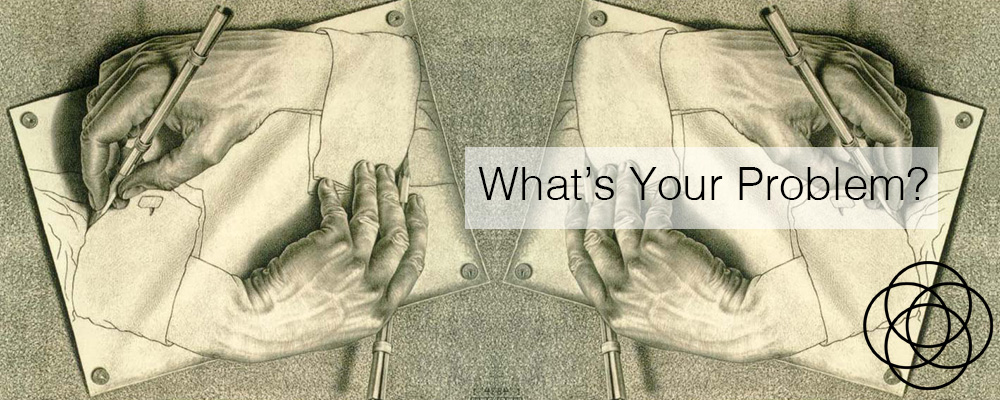Is there a problem you’re trying to solve in your life right now? Or maybe you prefer a more positive spin: Is there a challenge you’re encountering, ripe with opportunity and blessings that you’ve yet to see?
Looking back, what was the last problem you solved, and how did you do it? What was the last challenge you encountered, and how did you find the opportunities and blessings it offered?
The problems and challenges we face in our day to day lives are nightly processed in our dreams, although it takes a trained eye to see through the surreal dream drama into the working of the mind that created it. Once you know how to do this, you’ll see that most of our dreams reflect the problems or challenges we’re facing, and the inner conflicts (usually unconscious and such a surprise to us when we identify them) that hold us back from finding solutions.
Sometimes our dreaming mind finds a solution to a problem, or the opportunity in a challenge, and we wake up automatically wiser. We may not understand the dream, but the solution or opportunity will seemingly magically appear to us during the day. At other times, even though the dreaming mind comes up with a great solution, it may not trickle through to waking consciousness, or may take time to brew, or may be overridden by other issues that come up for us in the days that follow.
More often, though, our dreaming mind fails to find a solution to the problem or an opportunity in the challenge. The processing loops around the same old solutions we have tried before, the same old ways of looking at the situation, the same old ways of believing there’s a problem when perhaps it’s a problem of our own perspective. In this way, our dreams can reinforce our mindset, our conscious and unconscious beliefs, conflicts, and automatic habitual ways of seeing and responding in the world.
It’s quite comical really, the grand design that gives our problem-solving work to the very mind that is generally wired against seeing the solution. We struggle, blind, until we see. Then we can look back on our old way of perceiving the problem – on our limited perception – and see the funny side.
That said, there are ways to approach a dream, to break it down, to identify the problem and the limited beliefs (conscious and unconscious) that prevent you from seeing solutions.
Sometimes it turns out NOT to be about finding solutions, but about why you see a problem at all.
Here’s an extract from my book, The Compass, to illustrate this.
“Imagine your problem is a mountain blocking your path. You have just turned a corner and there it is, right in front of you, obstructing your access to the path beyond. From where you stand, you can see one steep, jagged, icy trail snaking up the mountainside, ending in a precipice overhanging a deep crevasse. Being so close to the mountain, your personal view is severely limited, and there appears to be no solution to this problem, no way of getting over it.
Now imagine moving several compass degrees to the left, and looking again. From this point of view, you might see an easier path zigzagging across rocky ledges, bypassing the top of the mountain, and seemingly leading to the other side. It’s a possible solution around the problem, but it’s risky and it would be a long, exhausting route to take.
Then picture finding a viewpoint several compass degrees to the right of the mountain, where you see a train waiting for you at a station, ready to zip you through a tunnel deep into the mountain and deliver you to the other side, fast and safe.
Other viewpoints may present other solutions. Further around on the compass dial, a new angle might reveal a lake nestled into the side of the mountain and a ferry boat that can take you across the lake to shortcut the journey you had originally intended and deliver you fifty kilometres beyond the mountain on your chosen path two days earlier than planned.
Yet another viewpoint might present you with a mountain guide prepared to take you safely up the mountain to spend time at a spiritual retreat perched in a Shangri La setting. This new view might entice you to change your original plan and follow the guide, while the magnificent bird’s eye view you get from the retreat might inspire you to choose an entirely new path from that point forward.
Or, at only two compass degrees round the mountain from where you started, you might meet a guru who sits you down to meditate on the existence of the mountain, whereupon you reach an epiphany: you realise that the mountain is made entirely of tiny particles of sand. It only appears to be a solid, immoveable rock. You see that all you have to do is take a deep breath and blow that mountain away. Your problem was not a problem after all. It was an illusion. What a discovery!
And so it continues. How you see your mountainous problem depends on your personal views and beliefs, and these are based on your unique life experiences and upbringing. Your personal views and beliefs limit the number of solutions you can see to a problem. If you can see your problem from a new viewpoint, a new angle, you will not only see new solutions to your problem, but you will also look back on where you originally stood and see your old self in a new light. You will see the person you were, with your old limiting beliefs and the blocks and problems they created for the old you. You will feel the shift as the old you fades, and the new you understands, smiles, and moves forward.” [end of extract]
Let your dreams help you to identify the limiting lens of your current mindset and discover new perspectives on … what was your problem again?

